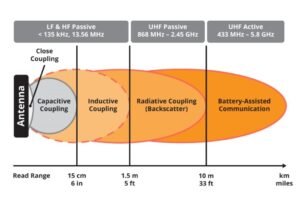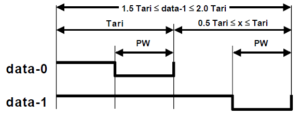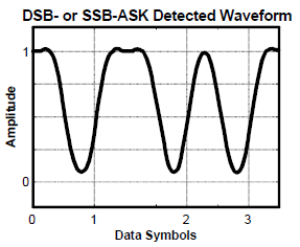RFID and Applications
Nowadays a 2-minute video on Amazon Go is trendy. You go into a shop, take whatever you need or want and go out without paying the cashier because there are no cashiers or payment points. The total will be charged to your Amazon account. Sounds very futuristic, right? This shop uses a combination of technologies but one of them, RFID (Radio Frequency Identification) is the leading technology. RFID is widely used today in many areas. In this paper working principles and uses of RFID are discussed.
What is RFID?
RFID (Radio Frequency Identification) is a form of wireless communication that uses radio waves to identify or track objects. This object can be anything you can think of: a book in the library, a Snickers bar in your local shop or even a wild animal roaming around the mountains. RFID was created in 1948 by scientist Harry Stockman and used mainly for military purposes. Starting from the 1970s it has been widely used but considered as too expensive to use on a large scale until recent years. used RFID systems consist of 3 elements.: RFID reader, RFID tags and antennas.
In an RFID system (Figure-1), the reader continuously transmits a radio wave from the antenna. When in the range, the tag antenna receives signals and harvests energy from the electromagnetic field. Using the power generated data stored in the tag is transmitted back to the reader. The reader picks up the tag radio waves and interprets them as meaningful data. The system works similarly to the barcode system. The data is encoded as a barcode. When a barcode is scanned, the scanner interprets the data. In the case of a barcode system, the barcode and scanner should be in the line of sight. On the contrary, RFID does not need a line of sight as long as the reader and the tag are within the range.

How does RFID work?
As discussed before, RFID systems have 3 main components: tag, reader and antenna.
RFID Tags
RFID Tags (transponders) are small devices that use low-power radio waves to receive, store and transmit data ta nearby readers. The main components are a microchip, or an integrated circuit (IC), an antenna and a substrate or protective material to hold everything together.

There are three types of RFID tags according to power sources. Passive tags do not have an internal power source, they use electromagnetic energy transmitted by the reader. Active tags have their internal battery to transmit signals. Semi-passive or battery-assisted passive (BAP) tags are basically a battery-adapted version of a passive tag.
The memory in RFID tags is generally less than 2000 kb which includes a unique identifier/serial number. Tags can be read only or read-write.
RFID Readers
RFID readers, also called interrogators, are the brains of the RFID systems. Readers transmit radio waves via an antenna to communicate with tags and receive incoming signals. They are typically divided into two types according to mobility. Fixed RFID Readers stay in one location and whereas Mobile RFID Readers are handheld and can be carried anywhere. Readers are generally connected to a computer to process incoming data from the RFID tags.
RFID Antennas
RFID antennas are crucial for the RFID system because they convert readers’ signals to radio waves that can be received by RFID tags. Tags have integrated antennas in the shape of a coil. The efficiency of generating waves of an antenna is called the antenna’s gain. As gain increases, the reach of the RF signal increases. Also, polarity can have a significant effect on the range of RFID systems. Generally circular or linear antennas are used. The polarity of the antenna and RFID tag should be aligned to maximize the range.
Types of RFID Systems
There are three main types of RFID systems according to frequency: Low Frequency (LF), High Frequency (HF) and Ultra High Frequency (UHF) (Figure 3).
Low-Frequency RFID systems: The frequency range is 30 KHz to 500 KHz where the typical frequency is 125 KHz. LF RFID systems have a short range from a few inches to three feet.
High-Frequency RFID systems: The frequency range is between 3-30 MHz with a typical HF frequency of 13.56 MHz. The range of transmission is from a few inches to several feet.
Ultra-High-Frequency RFID Systems: The frequency range is between 300-960. The range of transmission is more than 25 feet.

Countries regulate the frequencies that RFID systems transmit. It is important to know this regulation when buying or deploying an RFID system. Frequency ranges are regulated because each country allocates frequency ranges for a certain type of communication. In this way, interference is reduced. If RF waves are transmitted in the wrong frequencies, they can interfere with critical communications like military transmissions, aviation transmissions, or satellite communications.
It is hard to set a universal frequency band for UHF RFID because of the late adoption of UHF RFID and limited space in the mid-range of the Electromagnetic Spectrum. The Federal Communication Commission (FCC), the commission responsible for setting and upholding country-wide standards, regulates that UHD RFID equipment can only operate between 860-928 MHz. The range allocated in Europe by the European Telecommunications Standards Institute (ETSI) is 865-868 MHz.
Communication in RFID Systems
The communication between tag and reader in an RFID system relies on physics and electromagnetism. Communication is maintained mainly through the electromagnetic coupling method.
In order to communicate in the RFID system, the RFID tag and RFID reader tag circuit and reader circuit must couple in some way. Coupling is described as the transfer of energy between two electronic items or circuits. The type of coupling is determined by the range of reading and frequency of the system.

Close Coupling: Depending on the reader and tag, the coupling can be electric or electromagnetic. Electromagnetic coupling occurs when a tag and reader come close to 0.1-1 cm in a shared magnetic field. When the electric coupling is used, the surfaces of the tag and the reader should be brought parallel to each other to form an electric current.
Capacitive Coupling: Capacitive coupling uses electric currents instead of electromagnetic fields in order to couple. The range is limited to a few cm. for LF communication. The electric field is produced by using electrodes. Because of this coupling is effective for small distances. Application areas of this coupling are smart cards are key fobs (access control)
Inductive Coupling: Inductive coupling uses the magnetic field which limits the range to a few feet (1-1.5 m). Inductive coupling is observed in LF, HF and UHF applications that include coil antennas. Increasing the number of loops in coils results in an increase in the current generated in the tag. This also increases the strength of the magnetic field.
Radiative Coupling(Backscatter): Backscatter is not a true method of coupling, it is rather a communication method using electromagnetic waves between the reader and passive tags. General Electromagnetic waves are transmitted through the air from reader to tag. Some part of the energy received by the tag is used in the tag’s chip and a small amount of energy is reflected to communicate with the reader. Most of the UHF communication is maintained by using backscatter. The common exception is the state that the tag and the reader are in close proximity. In this case, the UHF RFID system chooses to couple magnetically or inductively. The communication range is 5 to 33 feet. Since backscatter is one of the most frequently used methods, a detailed explanation is needed.
Backscatter is a communication method between the RFID reader and an RFID tag that has no internal power source. The tag receives the energy from the electromagnetic waves propagated from the RFID reader. When the waves reach the tag’s antenna, energy travels through the antenna, activated chip or IC (integrated circuit). The remaining energy is modulated within the chip data and transmitted to the reader again in the form of electromagnetic waves. Backscatter is a bi-directional communication method. The same transmitted from the reader to the tag comes back again from the tag to the reader. The first phase of the transmission (from Reader to Tag) is called Forward Link and the second phase (from Tag to Reader) is called Reverse Link.
Forward Link (UHF)
The interrogation signal sent from the reader to the tag is called Forward Link. This signal’s aim is to energize the tag and receive a response from the tag. The signal is modulated at the reader between 860-960 MHz using DSB (Double Sideband)- ASK (Amplitude Shift Keying), SSB (Single Sideband) -ASK or PR (Phase Reversal)-ASK with PIE (Phase Reversal) encoding. The frequency choice is determined by the regional regulations.
- Amplitude Shift Keying (ASK) is the most used keying method for the Forward Link. ASK represents a 1 or 0 by shifting the amplitude.
- Double Sideband ASK (DSB-ASK) is the most common modulation method for ASK (Figure- 5).
- Single Sideband ASK (SSB-ASK) is used to limit the width of the spectrum occupied.
- Phase Reversal ASK (PR-ASK) is also used for different channel widths
- Pulse Interval Encoding (PIE) is the most commonly used encoding method for the Forward Link (Figure-6)

300

Reverse Link (UHF)
The response signal sent from the tag to the RFID reader is called Reverse Link. The data from the tag is sent back by switching the reflection coefficient of its antenna between high and low states. The tag will use a fixed modulation format which can be either ASK or PSK (Phase Shift Keying). Also, data transmitted by RFID tag is encoded by FM0 Baseband or Miller Encoding. The response from the tag, is detected and decoded at the RFID reader.
- Phase Shift Keying (PSK) or ASK can be used in the Reverse Link. Phase Shift Keying represents 0 or a 1 by changes in the phase of the carrier frequency.
- FM0 Baseband (Bi-Phase Space Coding), can be used instead of PIE during the Reverse Link
- Miller Encoded Subcarrier can also be used instead of PIE during the Reverse Link

RFID Applications and Use Areas
RFID dates back to 1948. However, it was started to be used frequently in 1970s. Due to high costs, in commercial use, it was highly avoided. As the hardware costs decreased in recent decades, use areas of RFID has increased drastically. Today we are using RFID in many areas without noticing.
Public Transport and Tolls: Public transport and electronic toll collection (ETC) are the areas where RFID is commonly used. To eliminate the delay in the toll collection point, RFID stickers (often called ‘Pass”) are used. In this way toll collection is automatically made from our accounts. Also, in public transport, prepaid transport passes use RFID technology.
Access Control: The RFID access control system is used to identify whose, when and where entering an area. Magnetic cards or key fobs are used for this purpose. Companies can track employees’ schedules by using RFID.
Passports: Biometric passports are the ones with an embedded chip. The chip holds the information about the passport holder. The information is stored in RFID chips and can be accessed via an RFID reader.
Logistics, Warehouses and Inventories: Tagged goods can be easily tracked and the content can easily be known. This saves a great amount of time in logistics and increases the profit. Inventories can be kept easily to manage warehouses efficiently.
Identification of Animals: RFID chips are used for animals in the same principle as passports. Breed information, as well as medical information, is stored in RFID chips. The information is accessible to veterinarians via an RFID reader.
Libraries and Museums: Libraries and museums are using RFID to track objects and manage their inventories just like warehouses. Besides this, RFID provides a security feature by tracking.
Supermarkets: By using RFID, a shopping experience with no cashiers, no lines and no money transfer is possible. Just like the Amazon Go store, mentioned above, checkout and inventory control and payment can be provided.
Timing of Sports Events: In the sports events, in which participants must be timed (races) RFID chips are used. When participants pass checkpoints, readers can track their time.
To sum up, RFID (Radio Frequency Identification) is a wireless communication technology that uses radio waves to identify or track objects. In an RFID system, the reader continuously transmits radio waves and when in the range, the tag receives signals and sends back signals with the data stored in it. Today, RFID has many applications such as Public Transport and Tolls, Passports, Access control and Logistics. It also provides us with a new shopping experience with no cashier or direct payment. As technology develops applications of RFID are also expanding.
References:
- RFID (radio frequency identification), Amsler, Shea, https://www.techtarget.com/iotagenda/definition/RFID-radio-frequency-identification
- What is RFID? | The Beginner’s Guide to How RFID Systems Work, https://www.atlasrfidstore.com/rfid-beginners-guide/
- What is RFID? How RFID works? RFID Explained in Detail, https://www.youtube.com/watch?v=Ukfpq71BoMo
- How RFID Works? and How to Design RFID Chips?, https://www.youtube.com/watch?v=FwbWvjq_iiM
- Amazon Go & RFID – The Automation Dilemma, Sattel, https://www.autodesk.com/products/eagle/blog/amazon-go-rfid-automation-dilemma/#:~:text=Amazon%20Go%20has%20a%20RFID,products%20you%20buy%20and%20how.
- Operating Principles: Coupling, Smiley,2016, https://www.atlasrfidstore.com/rfid-insider/operating-principles-coupling
- Explaining Backscatter – From Basic to Advanced Principles, Smiley, 2018, https://www.atlasrfidstore.com/rfid-insider/explaining-backscatter-from-basic-to-advanced-principles?utm_device=c&utm_feeditemid=&utm_term=&utm_source=google&utm_medium=cpc&utm_campaign=05+-+Dynamic+RLSA+-+US/CA/MX&hsa_cam=15073518707&hsa_grp=128934931157&hsa_mt=&hsa_src=g&hsa_ad=556034750119&hsa_acc=4442410237&hsa_net=adwords&hsa_kw=&hsa_tgt=aud-899351685961:dsa-19959388920&hsa_ver=3&gclid=Cj0KCQjwqPGUBhDwARIsANNwjV4FYCAmeeRrZ6qZlciEUq_NHr3DTeFtjYfO-lJwt8JQZrNP4rdeEQsaAkdCEALw_wcB
- What is RFID | Radio Frequency Identification Working Principle, https://www.electrical4u.net/instrumentation/radio-frequency-identification-working-principle/




